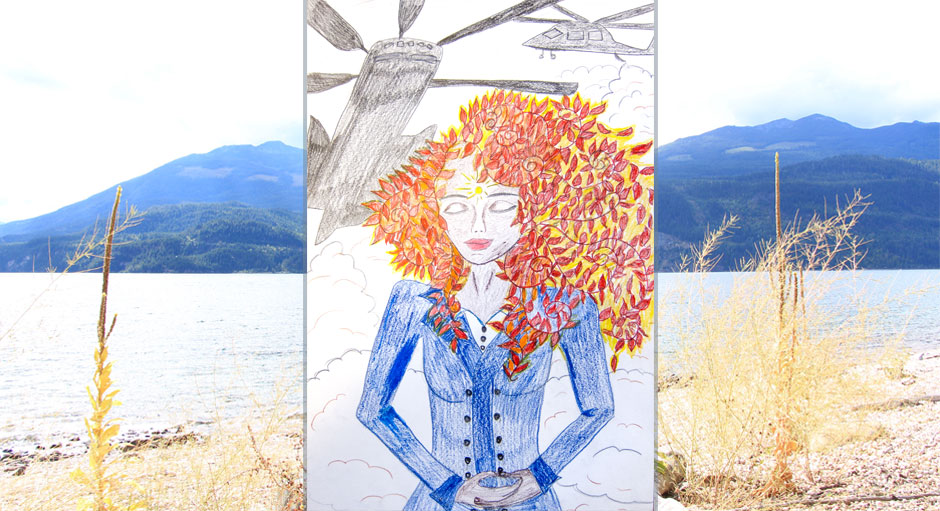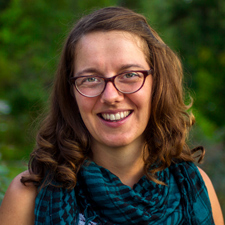
Image courtesy of Ashley Laframboise

Image courtesy of Ashley Laframboise
By Guenevere Neufeld
Helicopters were recently flying near the Ashram to replace the cones that hang off the power line in its wide stretch across Kootenay Lake. For four days their constant hover invaded the tranquil space of the grounds.
The sound of swiftly displacing air wound around buildings, entered through cracked-open windows and settled inside of me. The noise was a bother. Conversations centered on it. But for me it was more than that.
The sounds entered my cells and memories of my time in Israel and Palestine during the Gaza War in 2008-2009—a period of heightened conflict in the Middle East—came raging to the surface of my consciousness.
From a distanced Western perspective, conflict in the Middle East used to feel like a confusing jumble of war that happens far away. After spending three months there witnessing the war up close, it became no less confusing.
On December 27th, days after I had spent a quiet Christmas in Jerusalem, the Israel Defense Forces (IDF) were mobilized in response to the indiscriminate rocket fire launched over the borders from the Gaza Strip into Israel.
The rockets were reaching farther than before and the place where I was volunteering was now in range. It felt surreal, yet I quickly desensitized to the initial shock.
For the hundreds of thousands of people who live there, this was the norm and life continued on as usual. I slept with my passport and shoes ready for a nighttime run to the bomb shelter if the alarm sounded and arranged to leave the area sooner than originally planned, but lacked a sense of urgency to evacuate.
I saw fallen rockets smolder on hillsides. I watched Israeli fighter jets circle above me, my eyes following the missiles they launched into Gaza. In the evenings I read the news and learned how many people the missiles killed. Always there were helicopters.
The current humanitarian crises from Syria’s civil war has brought conflict in the Middle East directly into the awareness of the world in new ways. In the face of such disregard for human life, my heart demands I come to some sort of understanding about it all. I do my best to draw on my study and practice of yoga philosophy, and ultimately am left with my own personal responsibility to define and create peace in my own life.
Steven Schroeder, teaching chair of the University of Fraser Valley’s Peace and Conflict Studies, teaches courses on conflict and peacebuilding. He points out the differences between “negative peace”—ending overt physical violence—and building “positive peace,” which involves transforming our social, legal, economic and political structures.
“Peace building work is long difficult work, but anything worth doing takes time,” he says. “It takes the consideration of all people to be heard, understood and addressed. It takes a lot more time than just dropping a bomb.”
He’s spent time in Israel and Palestine and teaches a course on the Israeli-Palestinian conflict. As Steven explained the peace building perspective, I couldn’t help but note how it sounded a lot like yoga: pausing and adding self-reflection; getting clear about the facts; differentiating between and exploring our wants and needs; and being flexible and creative when looking for solutions collectively.
“It starts with how we view the world and how we live in our everyday lives,” says Steven.
He stressed the relationship between inner and outer peace, and the importance of having tools or a structure for peace to apply when we do find ourselves in conflict.
When it comes to ending conflict on the international scale, each change begins with the individual. “It’s actual human beings like you and me who take office,” says Steven. “It’s not people ‘out there’ who wage war. Making the decision to go to war or not can’t be completely separate to how politicians conduct their lives.”
Steven is pleased with the response in his classes of students who are given the tools for peace building and use them in their day-to-day lives. He sees his students pause and question their motivations and expand their awareness of what they take for granted. From there, it’s possible to find new ways to frame the narrative of peace building, beginning with how we see ourselves and how we see others.
“A big part of peace building is flexibility, creativity, and realizing that peace is built and isn’t just the absence of physical violence,” he says.
When it comes to framing my experiences in Palestine and Israel, I know I will never fully release those sounds and images from my memory. I do know I can use them as stark reminders of why I want to create peace in my own life and in every interaction I have.
Building peace is an involved process. It starts with my personal responsibility to use what I know through yoga to investigate what peace is in my own life. Peace spreads from there to create concentric circles outward. Together we generate a peaceful world.

Guenevere writes about applying a yogic foundation to her current experience of the world. Her work has appeared on The Tattooed Buddha, in the Concordian, Canadian Mennonite and Geez magazine. She has also been a columnist for Elephant Journal.
Read her other articles in Yoga in a Changing World.
“From a distanced Western perspective, conflict in the Middle East used to feel like a confusing jumble of war that happens far away. After spending three months there witnessing the war up close, it became no less confusing.”
Breathing in your words, breathing with Gratefullness for each moment LIVED and Celebrated…Extending Gratitude toward all brothers and sisters in this tormented world, viewing the inner LIGHT in each person, seeing all weapons melting…
In communion within the GIFT LIFE IS!
Reading this on a Monday morning – a great way to start my week. Thanks for the thoughtful beautiful piece, both words and art, that will stay with me…
Thanks Terry! Glad you enjoyed :)
Thank you for your thoughtful reflection on peace. We need to hear this now, I need to hear this now
Thanks Marcia. The message of peace is always a pertinent one. om om